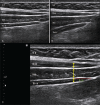Is abdominal hollowing exercise using real-time ultrasound imaging feedback helpful for selective strengthening of the transversus abdominis muscle?: A prospective, randomized, parallel-group, comparative study
- PMID: 29979423
- PMCID: PMC6076057
- DOI: 10.1097/MD.0000000000011369
Is abdominal hollowing exercise using real-time ultrasound imaging feedback helpful for selective strengthening of the transversus abdominis muscle?: A prospective, randomized, parallel-group, comparative study
Abstract
Despite the importance of strengthening of the transversus abdominis (TrA) muscle in individuals with low back pain, the effect of real-time ultrasound imaging on maintenance in selective strengthening of abdominal hallowing exercise (AHE) performance has not been investigated. So, the aim of this study was to investigate the effects of AHE with real-time ultrasound imaging feedback on selective reinforcing the TrA muscle.Twenty healthy subjects were enrolled prospectively and randomized to train AHE for 2 weeks either by conventional feedback (group A) or by visual feedback from real-time ultrasound imaging additional to conventional feedback (group B). The changes in thickness of TrA, internal oblique abdominal muscle (IO), and external oblique abdominal muscle (EO) were measured using the ultrasonography. The changes in muscle activities of TrA-IO and EO were measured using surface electromyography.The thickness of TrA, IO, and EO muscles in resting was not significantly changed in both groups A and B. However, the ratio of root mean square (RMS) values of TrA-IO/EO muscles, which mirrors selective contraction of TRA-IO muscles against EO muscle, was significantly higher in group B than in group A.In healthy subjects, training with AHE using real-time ultrasound imaging feedback may be a useful additional method to conventional feedback for strengthening the TrA muscles selectively.
Conflict of interest statement
The authors have no conflicts of interest to disclose.
Figures




References
-
- Macedo LG, Maher CG, Latimer J, et al. Motor control exercise for persistent, nonspecific low back pain: a systematic review. Phys Ther 2009;89:9–25. - PubMed
-
- Panjabi MM. Clinical spinal instability and low back pain. J Electromyogr Kinesiol 2003;13:371–9. - PubMed
-
- Hides JA, Jull GA, Richardson CA. Long-term effects of specific stabilizing exercises for first-episode low back pain. Spine (Phila Pa 1976) 2001;26:E243–8. - PubMed
-
- Hides J, Gilmore C, Stanton W, et al. Multifidus size and symmetry among chronic LBP and healthy asymptomatic subjects. Man Ther 2008;13:43–9. - PubMed
-
- Hodges PW, Richardson CA. Altered trunk muscle recruitment in people with low back pain with upper limb movement at different speeds. Arch Phys Med Rehabil 1999;80:1005–12. - PubMed
Publication types
MeSH terms
LinkOut - more resources
Full Text Sources
Other Literature Sources

